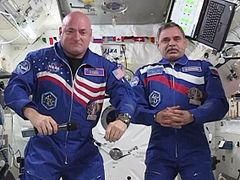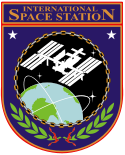Ekspedycja 43
 | |
| Pojazd | |
| Pojazd dowożący | Sojuz TMA-15M, Sojuz TMA-16M |
|---|---|
| Załoga | |
 Zdjęcie załogi, od lewej: Giennadij Padałka, Scott Kelly, Anton Szkaplerow, Samantha Cristoforetti, Michaił Kornijenko, Terry Virts | |
| Załoga | 6 |
| Start | |
| Miejsce startu | Kosmodrom Bajkonur, Kazachstan |
| Początek misji | 11 marca 2015, 22:44:03 UTC rozpoczęcie Ekspedycji 43 |
| Misja ISS | |
| Lądowanie | |
| Lądowanie | 11 czerwca 2015, 10:25:05 UTC zakończenie Ekspedycji 43 |
| Czas trwania misji | 91 d 11 h 41 min 02 s |
| Międzynarodowa Stacja Kosmiczna | |
Ekspedycja 43 – stała załoga Międzynarodowej Stacji Kosmicznej, która sprawowała swoją misję od 11 marca do 11 czerwca 2015 roku. Ekspedycja 43 rozpoczęła się wraz z odłączeniem od stacji statku Sojuz TMA-14M i trwała do odcumowania od ISS statku Sojuz TMA-15M.
Załoga
Astronauci Anton Szkaplerow, Samantha Cristoforetti i Terry Virts przybyli na ISS 24 listopada 2014 roku na pokładzie Sojuza TMA-15M i weszli w skład Ekspedycji 42[1]. Początkowo znajdowali się na stacji jedynie w trójkę. 28 marca 2015 roku dołączyli do nich Giennadij Padałka, Michaił Kornijenko i Scott J. Kelly, którzy przybyli na pokładzie Sojuza TMA-16M[2].
Gdy 11 czerwca 2015 roku Sojuz TMA-15M odłączył się od stacji ze Szkaplerowem, Cristoforetti i Virtsem na pokładzie, zakończyła się misja Ekspedycji 43. Jednocześnie kosmonauci Padałka, Kornijenko i Kelly przeszli w skład 44. stałej załogi ISS[3][4].
| Funkcja | Pierwsza część 11-28.03.2015 | Druga część 28.03-11.06.2015 |
|---|---|---|
| Dowódca | 2. lot kosmiczny[5] | |
| Inżynier pokładowy 1 | 2. lot kosmiczny[6] | |
| Inżynier pokładowy 2 | 1. lot kosmiczny[7] | |
| Inżynier pokładowy 3 | 5. lot kosmiczny[8] | |
| Inżynier pokładowy 4 | 2. lot kosmiczny[9] | |
| Inżynier pokładowy 5 | 4. lot kosmiczny[10] | |
Aktywność na stacji

W czasie Ekspedycji 43 na ISS przebywali astronauci Scott Kelly i Michaił Kornijenko, którzy uczestniczyli w projekcie badawczym Year Long Mission. Miał on na celu zbadanie skutków zdrowotnych długotrwałego przebywania w kosmosie, aby możliwym stało się odpowiednie przygotowanie przyszłych załogowych misji eksploracji Układu Słonecznego. Obaj kosmonauci spędzili na ISS prawie 340 dni i byli członkami 43., 44., 45. i 46. stałej załogi stacji.
Celem długotrwałej misji było lepsze zrozumienie zmian zachodzących w organizmie astronautów w celu udoskonalenia procedur dotyczących zapobiegania utraty masy mięśniowej, co jest skutkiem stanu nieważkości w przestrzeni kosmicznej. Na Międzynarodowej Stacji Kosmicznej znajdują się specjalne urządzenia do ćwiczeń, które pozwalają astronautom zredukować negatywne skutki zdrowotne długotrwałego pobytu w kosmosie. Jednak wykonywane na stacji ćwiczenia nie są w stanie w pełni zatrzymać utraty masy mięśniowej. W szczególności obserwowane były zmiany zachodzące w organizmie Scotta Kelly'ego, który ma brata bliźniaka Marka Kelly'ego, który również jest astronautą. Mark w tym czasie przebywał na Ziemi i dzięki temu możliwe było porównanie zmian zachodzących w ciałach obu astronautów i dokładniejsze zdefiniowanie skutków długotrwałego lotu kosmicznego[11]. Jednocześnie ten program badawczy miał również sprawdzić zmiany zachodzące w psychice astronautów, którzy znajdują się w zamkniętej przestrzeni przez dłuższy czas[12].
Galeria
Załoga Ekspedycji 43 w module Destiny
Stół z pożywieniem dla załogi w module Unity
Samantha Cristoforetti w module Columbus
Scott Kelly (z lewej) i Terry Virts podczas prac w module Kibō
Przedział personalny astronautów w module Harmony - w tym przypadku przedział wykorzystywany przez Scotta Kelly'ego
Terry Virts zamyka właz do modułu Leonardo, który następnie został przeniesiony z modułu Unity na Tranquility
Zobacz też
- lista ekspedycji na Międzynarodową Stację Kosmiczną
- lista załogowych lotów kosmicznych do Międzynarodowej Stacji Kosmicznej
- lista gości Międzynarodowej Stacji Kosmicznej
- alfabetyczna lista astronautów i kosmonautów
Przypisy
- ↑ Sojuz TMA-15M, Loty kosmiczne [dostęp 2016-08-20].
- ↑ Sojuz TMA-16M, Loty kosmiczne [dostęp 2016-08-21].
- ↑ Expedition 43 Summary, NASA [dostęp 2016-08-20].
- ↑ Expedition 44 Summary, NASA [dostęp 2016-08-21].
- ↑ T. W. Virts, Jr., Loty kosmiczne [dostęp 2016-08-20].
- ↑ A. N. Szkaplerow, Loty kosmiczne [dostęp 2016-08-20].
- ↑ S. Cristoforetti, Loty kosmiczne [dostęp 2016-08-20].
- ↑ G. I. Padałka, Loty kosmiczne [dostęp 2016-08-21].
- ↑ M. B. Kornijenko, Loty kosmiczne [dostęp 2016-08-21].
- ↑ S. J. Kelly, Loty kosmiczne [dostęp 2016-08-21].
- ↑ One-Year ISS Mission Preview: 28 Experiments, 4 Expeditions and 2 Crew Members [dostęp 2016-07-16].
- ↑ Chris Arridge, Record-breaking astronauts return to Earth – taking us one step closer to Mars [dostęp 2016-07-16].
Linki zewnętrzne
Media użyte na tej stronie
The flag of Navassa Island is simply the United States flag. It does not have a "local" flag or "unofficial" flag; it is an uninhabited island. The version with a profile view was based on Flags of the World and as a fictional design has no status warranting a place on any Wiki. It was made up by a random person with no connection to the island, it has never flown on the island, and it has never received any sort of recognition or validation by any authority. The person quoted on that page has no authority to bestow a flag, "unofficial" or otherwise, on the island.
The new ISSpresso machine was recently installed on the International Space Station. In order to utilize the ISSpresso, a NASA standard drink bag is installed, along with a capsule containing the beverage item that the crew member wishes to drink. After the item has been brewed, the used capsule and the drink bag are removed.
Expedition 43 Astronaut Scott Kelly and Cosmonaut Mikhail Kurnyienko inside the ISS's Japanese Kibo lab module
The hexagon (six-sided) shape of the Expedition 43 patch represents the six crew members living and working onboard the orbital outpost. The International Space Station (ISS) is portrayed in orbit around the Earth, representing the multi-national partnership that has constructed, developed, and continues to operate the ISS for the benefit of all humankind. The sunrise marks the beginning of a new day, reflecting the fact that we're at the dawn of our history as a space faring species. The moon and planets represent future exploration of our solar system, for which the ISS is a stepping stone. Finally, the five stars honor the crews who have lost their lives during the pursuit of human spaceflight.
ESA (European Space Agency) astronaut Samantha Cristoforetti, Expedition 43 flight engineer aboard the International Space Station, is seen working on a science experiment that includes photographic documentation of Cellular Responses to Single and Combined Space Flight Conditions. Some effects of the space environment level appear to act at the cellular level and it is important to understand the underlying mechanisms of these effects. This science project uses invertebrate hemocytes to focus on two aspects of cellular function which may have medical importance. The synergy between the effects of the space radiation environment and microgravity on cellular function is the goal of this experiment along with studying the impairment of immune functions under spaceflight conditions.
A view of the food table located in the
NASA astronaut Scott Kelly on the International Space Station shows off his personal living quarters in space. Scott tweeted this image out with the comment: " My #bedroom aboard #ISS. All the comforts of #home. Well, most of them. #YearInSpace".
All six Expedition 43 crewmembers are gathered in the Destiny laboratory on board the International Space Station on Mar 30, 2015 after an emergency procedures training period. The six members include Russian cosmonauts Mikhail Kornienko (top left), Anton Shkaplerov, Gennady Padalka, NASA Astronaut Scott Kelly, ESA (European Space Agency) astronaut Samantha Cristoforetti (bottom left), and Expedition 43 commander US astronaut Terry Virts.
Expedition 43 crew members take a break from training at NASA's Johnson Space Center to pose for a crew portrait. Pictured from the right are NASA astronaut Terry Virts, commander; along with Russian cosmonaut Mikhail Kornienko, European Space Agency astronaut Samantha Cristoforetti, Russian cosmonaut Anton Shkaplerov, NASA astronaut Scott Kelly and Russian cosmonaut Gennady Padalka, all flight engineers.
Expedition 43 commander and NASA astronaut Terry Virts is seen here closing the hatch to the Leonardo Permanent Multipurpose Module (PMM.) The PMM was moved on May 27, 2015 from the Unity node to the Tranquility node. This freed up a docking port on the Earth-facing side of Unity for visiting cargo vehicles and was the latest activity in the ongoing upgrades to the station to prepare for future U.S. commercial crew vehicles.
NASA astronauts Scott Kelly (left) and Terry Virts (right) work on a Carbon Dioxide Removal Assembly (CDRA) inside the station's Japanese Experiment Module. The CDRA system works to remove carbon dioxide from the cabin air, allowing for an environmentally safe crew cabin.





















